2005 CHEVROLET COLORADO airbag
[x] Cancel search: airbagPage 56 of 414
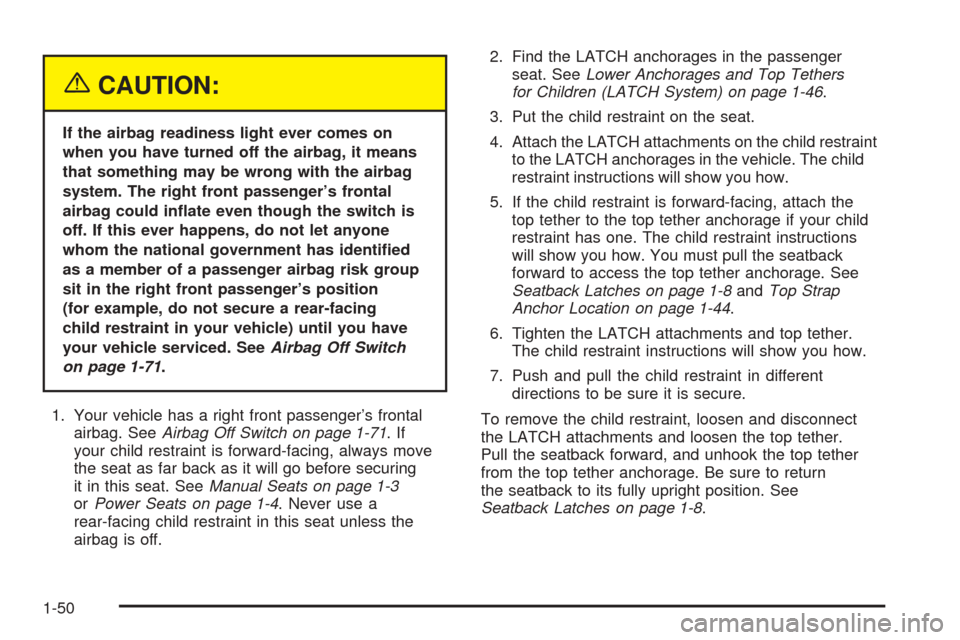
{CAUTION:
If the airbag readiness light ever comes on
when you have turned off the airbag, it means
that something may be wrong with the airbag
system. The right front passenger’s frontal
airbag could in�ate even though the switch is
off. If this ever happens, do not let anyone
whom the national government has identi�ed
as a member of a passenger airbag risk group
sit in the right front passenger’s position
(for example, do not secure a rear-facing
child restraint in your vehicle) until you have
your vehicle serviced. SeeAirbag Off Switch
on page 1-71.
1. Your vehicle has a right front passenger’s frontal
airbag. SeeAirbag Off Switch on page 1-71.If
your child restraint is forward-facing, always move
the seat as far back as it will go before securing
it in this seat. SeeManual Seats on page 1-3
orPower Seats on page 1-4. Never use a
rear-facing child restraint in this seat unless the
airbag is off.2. Find the LATCH anchorages in the passenger
seat. SeeLower Anchorages and Top Tethers
for Children (LATCH System) on page 1-46.
3. Put the child restraint on the seat.
4. Attach the LATCH attachments on the child restraint
to the LATCH anchorages in the vehicle. The child
restraint instructions will show you how.
5. If the child restraint is forward-facing, attach the
top tether to the top tether anchorage if your child
restraint has one. The child restraint instructions
will show you how. You must pull the seatback
forward to access the top tether anchorage. See
Seatback Latches on page 1-8andTop Strap
Anchor Location on page 1-44.
6. Tighten the LATCH attachments and top tether.
The child restraint instructions will show you how.
7. Push and pull the child restraint in different
directions to be sure it is secure.
To remove the child restraint, loosen and disconnect
the LATCH attachments and loosen the top tether.
Pull the seatback forward, and unhook the top tether
from the top tether anchorage. Be sure to return
the seatback to its fully upright position. See
Seatback Latches on page 1-8.
1-50
Page 57 of 414
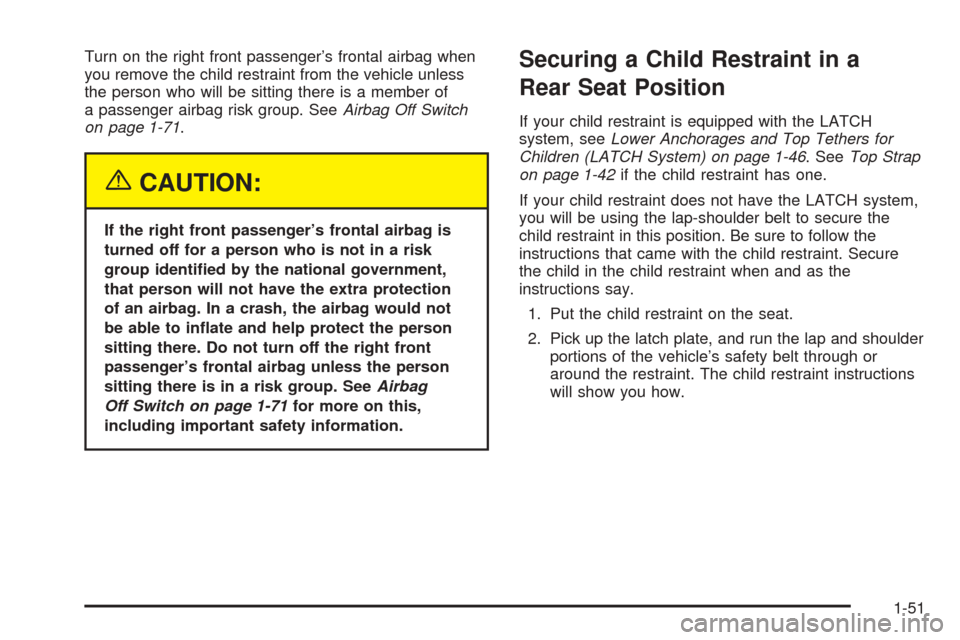
Turn on the right front passenger’s frontal airbag when
you remove the child restraint from the vehicle unless
the person who will be sitting there is a member of
a passenger airbag risk group. SeeAirbag Off Switch
on page 1-71.
{CAUTION:
If the right front passenger’s frontal airbag is
turned off for a person who is not in a risk
group identi�ed by the national government,
that person will not have the extra protection
of an airbag. In a crash, the airbag would not
be able to in�ate and help protect the person
sitting there. Do not turn off the right front
passenger’s frontal airbag unless the person
sitting there is in a risk group. SeeAirbag
Off Switch on page 1-71for more on this,
including important safety information.
Securing a Child Restraint in a
Rear Seat Position
If your child restraint is equipped with the LATCH
system, seeLower Anchorages and Top Tethers for
Children (LATCH System) on page 1-46. SeeTop Strap
on page 1-42if the child restraint has one.
If your child restraint does not have the LATCH system,
you will be using the lap-shoulder belt to secure the
child restraint in this position. Be sure to follow the
instructions that came with the child restraint. Secure
the child in the child restraint when and as the
instructions say.
1. Put the child restraint on the seat.
2. Pick up the latch plate, and run the lap and shoulder
portions of the vehicle’s safety belt through or
around the restraint. The child restraint instructions
will show you how.
1-51
Page 60 of 414

Securing a Child Restraint in the
Right Front Seat Position (Models
without an Airbag Off Switch)
Crew Cab Models and Extended Cab
Models with Rear Seats
If your child restraint is equipped with the LATCH
system, seeLower Anchorages and Top Tethers for
Children (LATCH System) on page 1-46. SeeTop Strap
on page 1-42if the child restraint has one.
There is no top strap anchor in the right front
passenger’s position. Do not secure a child seat in
this position if a national or local law requires that the
top strap be anchored, or if the instructions that
come with the child restraint say that the top strap
must be anchored. SeeTop Strap on page 1-42if
the child restraint has one.
Your vehicle has a right front passenger airbag.
Neverput a rear-facing child restraint in the right
front passenger’s seat. Here is why:
{CAUTION:
A child in a rear-facing child restraint can be
seriously injured or killed if the right front
passenger’s airbag in�ates. This is because
the back of the rear-facing child restraint
would be very close to the in�ating airbag.
Always secure a rear-facing child restraint in
a rear seat.
A rear seat is a safer place to secure a forward-facing
child restraint. If you need to secure a forward-facing
child restraint in the right front seat position, seeWhere
to Put the Restraint on page 1-40.
If your child restraint does not have the LATCH system,
you will be using the lap-shoulder belt to secure the
child restraint in this position. Be sure to follow the
instructions that came with the child restraint. Secure
the child in the child restraint when and as the
instructions say.
1. Because your vehicle has a right front passenger’s
frontal airbag, always move the seat as far back as
it will go before securing a forward-facing child
restraint. SeeManual Seats on page 1-3orPower
Seats on page 1-4.
1-54
Page 62 of 414
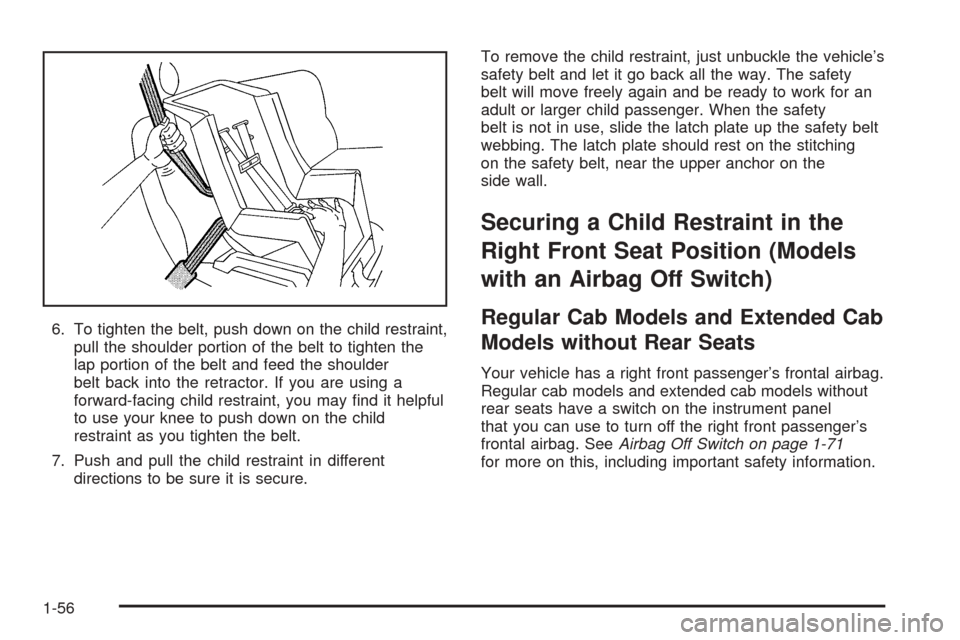
6. To tighten the belt, push down on the child restraint,
pull the shoulder portion of the belt to tighten the
lap portion of the belt and feed the shoulder
belt back into the retractor. If you are using a
forward-facing child restraint, you may �nd it helpful
to use your knee to push down on the child
restraint as you tighten the belt.
7. Push and pull the child restraint in different
directions to be sure it is secure.To remove the child restraint, just unbuckle the vehicle’s
safety belt and let it go back all the way. The safety
belt will move freely again and be ready to work for an
adult or larger child passenger. When the safety
belt is not in use, slide the latch plate up the safety belt
webbing. The latch plate should rest on the stitching
on the safety belt, near the upper anchor on the
side wall.
Securing a Child Restraint in the
Right Front Seat Position (Models
with an Airbag Off Switch)
Regular Cab Models and Extended Cab
Models without Rear Seats
Your vehicle has a right front passenger’s frontal airbag.
Regular cab models and extended cab models without
rear seats have a switch on the instrument panel
that you can use to turn off the right front passenger’s
frontal airbag. SeeAirbag Off Switch on page 1-71
for more on this, including important safety information.
1-56
Page 63 of 414
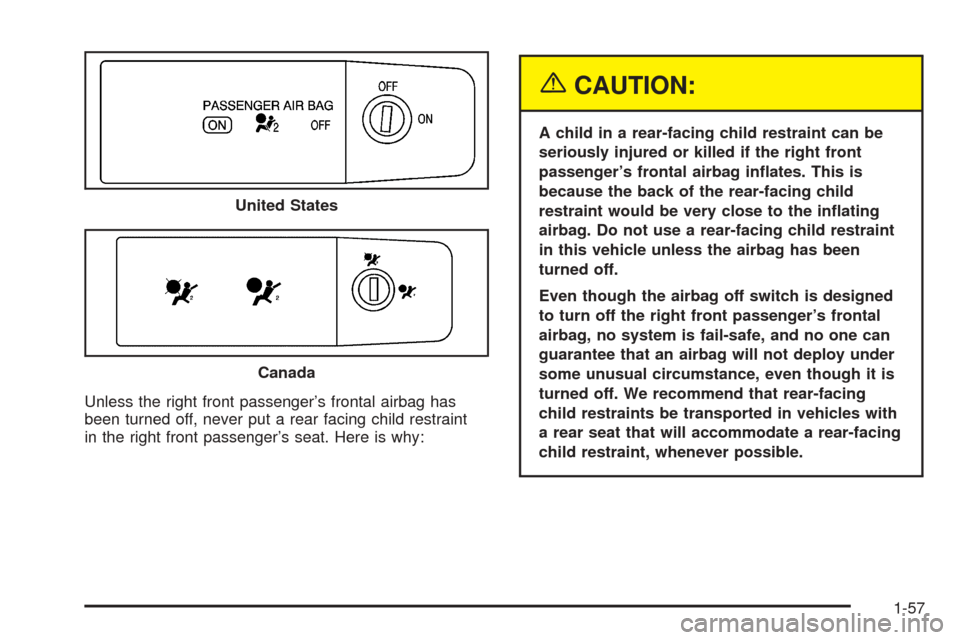
Unless the right front passenger’s frontal airbag has
been turned off, never put a rear facing child restraint
in the right front passenger’s seat. Here is why:
{CAUTION:
A child in a rear-facing child restraint can be
seriously injured or killed if the right front
passenger’s frontal airbag in�ates. This is
because the back of the rear-facing child
restraint would be very close to the in�ating
airbag. Do not use a rear-facing child restraint
in this vehicle unless the airbag has been
turned off.
Even though the airbag off switch is designed
to turn off the right front passenger’s frontal
airbag, no system is fail-safe, and no one can
guarantee that an airbag will not deploy under
some unusual circumstance, even though it is
turned off. We recommend that rear-facing
child restraints be transported in vehicles with
a rear seat that will accommodate a rear-facing
child restraint, whenever possible. United States
Canada
1-57
Page 64 of 414
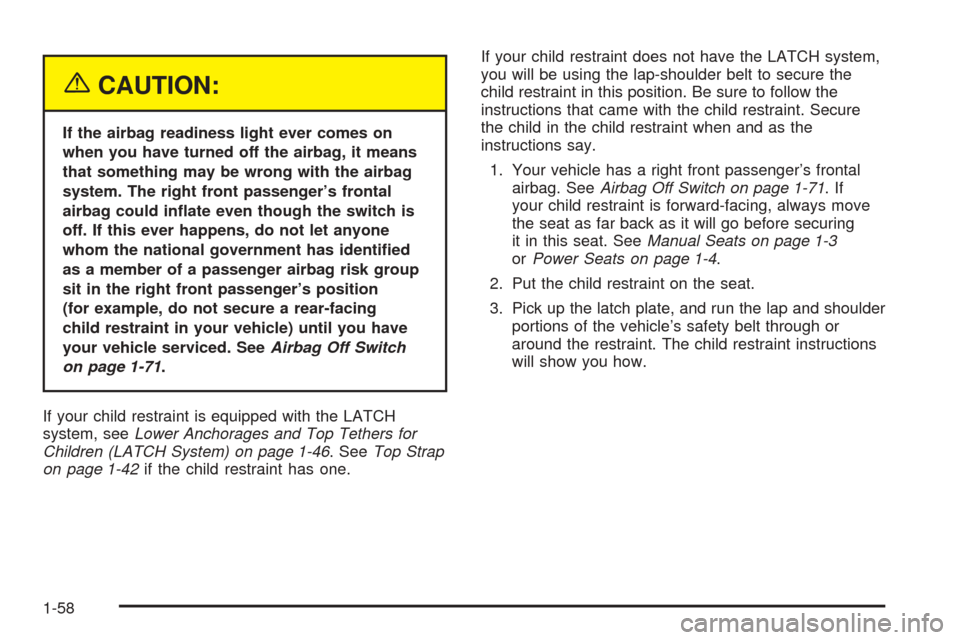
{CAUTION:
If the airbag readiness light ever comes on
when you have turned off the airbag, it means
that something may be wrong with the airbag
system. The right front passenger’s frontal
airbag could in�ate even though the switch is
off. If this ever happens, do not let anyone
whom the national government has identi�ed
as a member of a passenger airbag risk group
sit in the right front passenger’s position
(for example, do not secure a rear-facing
child restraint in your vehicle) until you have
your vehicle serviced. SeeAirbag Off Switch
on page 1-71.
If your child restraint is equipped with the LATCH
system, seeLower Anchorages and Top Tethers for
Children (LATCH System) on page 1-46. SeeTop Strap
on page 1-42if the child restraint has one.If your child restraint does not have the LATCH system,
you will be using the lap-shoulder belt to secure the
child restraint in this position. Be sure to follow the
instructions that came with the child restraint. Secure
the child in the child restraint when and as the
instructions say.
1. Your vehicle has a right front passenger’s frontal
airbag. SeeAirbag Off Switch on page 1-71.If
your child restraint is forward-facing, always move
the seat as far back as it will go before securing
it in this seat. SeeManual Seats on page 1-3
orPower Seats on page 1-4.
2. Put the child restraint on the seat.
3. Pick up the latch plate, and run the lap and shoulder
portions of the vehicle’s safety belt through or
around the restraint. The child restraint instructions
will show you how.
1-58
Page 67 of 414
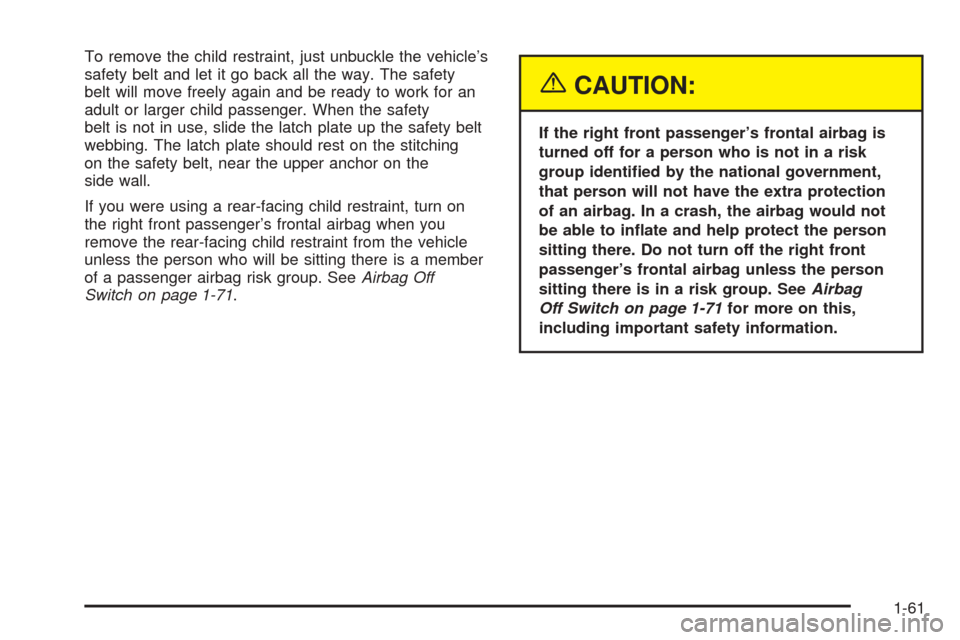
To remove the child restraint, just unbuckle the vehicle’s
safety belt and let it go back all the way. The safety
belt will move freely again and be ready to work for an
adult or larger child passenger. When the safety
belt is not in use, slide the latch plate up the safety belt
webbing. The latch plate should rest on the stitching
on the safety belt, near the upper anchor on the
side wall.
If you were using a rear-facing child restraint, turn on
the right front passenger’s frontal airbag when you
remove the rear-facing child restraint from the vehicle
unless the person who will be sitting there is a member
of a passenger airbag risk group. SeeAirbag Off
Switch on page 1-71.
{CAUTION:
If the right front passenger’s frontal airbag is
turned off for a person who is not in a risk
group identi�ed by the national government,
that person will not have the extra protection
of an airbag. In a crash, the airbag would not
be able to in�ate and help protect the person
sitting there. Do not turn off the right front
passenger’s frontal airbag unless the person
sitting there is in a risk group. SeeAirbag
Off Switch on page 1-71for more on this,
including important safety information.
1-61
Page 68 of 414
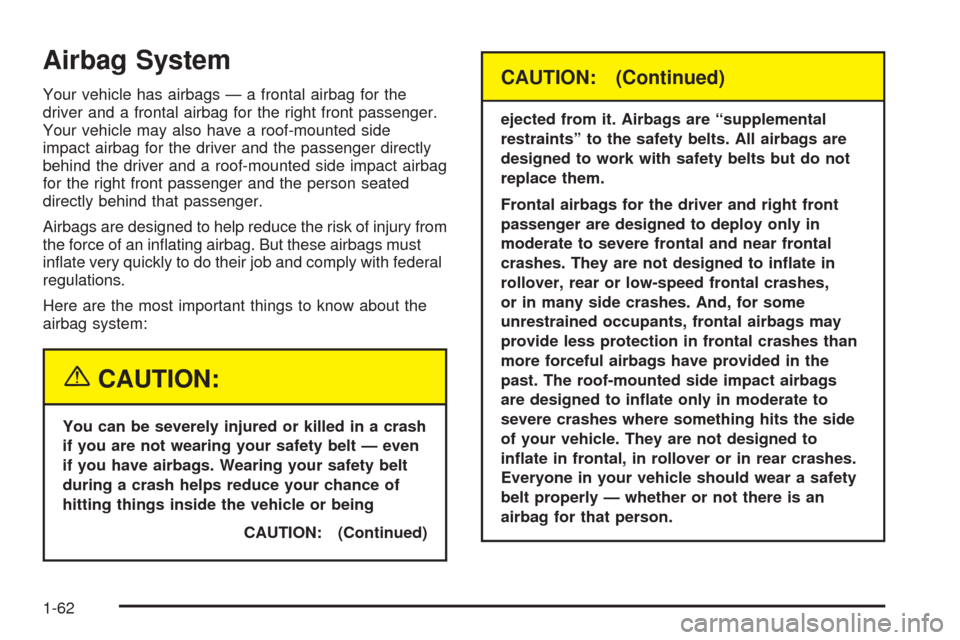
Airbag System
Your vehicle has airbags — a frontal airbag for the
driver and a frontal airbag for the right front passenger.
Your vehicle may also have a roof-mounted side
impact airbag for the driver and the passenger directly
behind the driver and a roof-mounted side impact airbag
for the right front passenger and the person seated
directly behind that passenger.
Airbags are designed to help reduce the risk of injury from
the force of an in�ating airbag. But these airbags must
in�ate very quickly to do their job and comply with federal
regulations.
Here are the most important things to know about the
airbag system:
{CAUTION:
You can be severely injured or killed in a crash
if you are not wearing your safety belt — even
if you have airbags. Wearing your safety belt
during a crash helps reduce your chance of
hitting things inside the vehicle or being
CAUTION: (Continued)
CAUTION: (Continued)
ejected from it. Airbags are “supplemental
restraints” to the safety belts. All airbags are
designed to work with safety belts but do not
replace them.
Frontal airbags for the driver and right front
passenger are designed to deploy only in
moderate to severe frontal and near frontal
crashes. They are not designed to in�ate in
rollover, rear or low-speed frontal crashes,
or in many side crashes. And, for some
unrestrained occupants, frontal airbags may
provide less protection in frontal crashes than
more forceful airbags have provided in the
past. The roof-mounted side impact airbags
are designed to in�ate only in moderate to
severe crashes where something hits the side
of your vehicle. They are not designed to
in�ate in frontal, in rollover or in rear crashes.
Everyone in your vehicle should wear a safety
belt properly — whether or not there is an
airbag for that person.
1-62